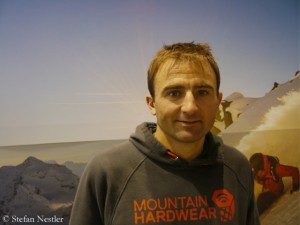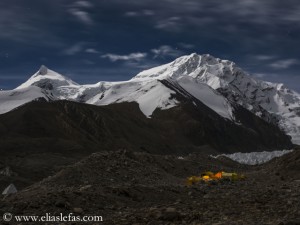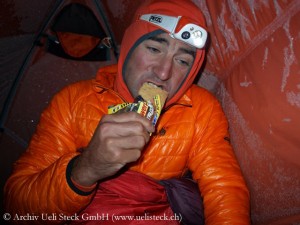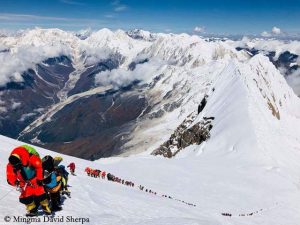Ueli Steck: “I accept the risk”
Actually, Ueli Steck only wanted to do an active holiday in Tibet in autumn 2014. The 38-year-old top climber from Switzerland planned to climb the eight-thousander Shishapangma with his wife Nicole via the normal route. It soon became clear that it would not be as easy as it seemed first because there was too much snow on the mountain. “But just sitting around in the base camp, that’s really not my thing”, Ueli told me last week at the trade fair ISPO in Munich. “Thus I accompanied the guys in their summit attempt.” These guys were the German ski mountaineers Benedikt Boehm, Sebastian Haag and Martin Maier and the Italian Andrea Zambaldi. In the summit area, an avalanche descended: Haag and Zambaldi died, Maier survived seriously injured. Only Steck and Boehm were not swept away by the avalanche. Reason enough to talk with Ueli about risk and luck:
Ueli, people say, a cat has nine lives. How many lives do you have?
Oh, how many lives? I have already been very lucky a few times. But I don’t count these experiences because that makes you just crazy. When you go to the mountains, you run a certain risk. And you just have to accept it.
Last fall on Shishapangma, an avalanche that went off in the summit area killed the ski mountaineers Sebastian Haag and Andrea Zambaldi. You were there, how close was it for you?
It was only luck that Beni (Boehm) and I were standing a bit further up. We also stood in the avalanche zone, but just a little bit on the side where not so much snow slipped away. We didn’t lose our footing, while the others were swept away. It was very close.
In a situation like this, how much is luck, how much instinct?
It’s difficult to say. Instinct means making decisions unconsciously. That’s something you can’t measure. There are really people doing almost always the right thing, and people say, they are always lucky. But what is luck? Maybe you make the right decision instinctively and stand on the right place. I wouldn’t necessarily say I survived due to my instinct. But I would neither say it was just pure luck. I simply can’t explain it.
You’ve already experienced several situations such as this. For example in 2007, when you were hit by a stone on your head at the Annapurna South Face and fell down unconscious several hundred meters.
That was pure luck. The only misfortune in this situation was being hit by the stone, the rest was pure luck. This had nothing to do with instinct or whatever.
How do you deal with such an experience? Do you have a professional handling so that you can start the next project free from bias or do you reflect it like a layman would do?
I am very concerned about it. I must admit, that the Annapurna story in 2013 (Ueli risked much as he soloed the South Face on a route that had not yet been completed until then. It took him only 28 hours for ascent and descent.) threw me right off the track. Actually, it is very simple: When we climb mountains we try to take good decisions and not to run too much risk. In the end, however, we just have to make it clear that once we go to the mountains, no matter on what level, we risk an accident. For me, it’s only either black or white. Either I just accept it or not. If I don’t accept it, I can’t go to the mountains. But climbing and all the experiences when I do it are simply too important for me and give me too much. Therefore I accept the risk.
Are you as a professional climber forced to take a greater risk to be recognized?
No, I‘m absolutely not forced to anything. I can do whatever I want. I make my decisions for myself. When I set off, I have prepared the project for so long that it is feasible. I don’t have in mind: If I survive, I make a profitable business out of it. If I set off, I want to come back. This is a decisive factor. But of course I am in a different league compared to those who make an easy hike. On this high-end level, the risk is automatically much higher.
You always try to push your personal limits. Is there no danger of stripping the screw? Is it possible to say at some point: Enough is enough, that was the riskiest thing I’ve done, now I turn back the screw a bit?
That is exactly what is so difficult, and I’m aware of that. For example Annapurna: I reflected what happened there, and I was concerned about it. Actually, I’m the only one who can really judge how much risk I took and how much commitment I put into the climb. And let me tell you, it was much. I even accepted that I probably would not come back alive. And that’s too much. It’s easy to say here at the table, I turn back the screw a bit. But it’s a huge process really to feel it, to be able to hold your horses without thinking you should go even further. Just now I can’t say: I will no longer go to the Himalayas. And I know, if I’m in this situation again, I will make the same decision as I did on Annapurna and accept that risk.
Not too long ago, you said that due to the high risk the time of your solo-climbs was over and that you would henceforth prefer climbing in teams. In 2011, you left for Shishapangma in twos, but in the end you climbed solo through the South Face. The same on Annapurna in 2013. Is it difficult for you to find equally strong partners?
At least I try. (laughs) It didn’t work twice. It’s difficult to find someone who is at the same level and can also translate it into action. I have just this experience of solo climbs, thus it is always an option. That will always be the same in my life. It also happened to me when I wanted to climb the Eiger North Face with a friend. At the foot of the wall he said he felt bad and wouldn’t join me. Then I had the option to say: The weather is nice, I’ll climb anyway. See you for a drink at the Kleine Scheidegg station buffet in the afternoon!
Others would turn around.
Yes, because they do not have this option. Therefore, I find myself in these situations again and again.
What will you do next?
I really try to turn back the screw a bit. I plan a traverse in the Alps, all four-thousanders, with (the German climber) Michi Wohlleben. We just want to have fun to climb. In fall, I’ll go to Nuptse where I and Colin Haley want to repeat the route of Valery Babanov in Alpine style.
For explanation: In 2003, the Russians Valery Babanov and Yuri Kosholenko for the first time succeeded in reaching the summit of 7,804-meter-high Nuptse East (in the neighborhood of Mount Everest) via the South Pillar. They fixed ropes up to 6,400 meters – what resulted in a heated debate about their style of climbing. The route “had been desecrated by bolts and fixed ropes”, criticized US-climber Steve House, who had reached an altitude of 7,200 meters on the same route in Alpine Style in 2002. Babanov countered: “The mountain is waiting, you just need to go there and climb it!” That’s exactly what Ueli wants to do now.











